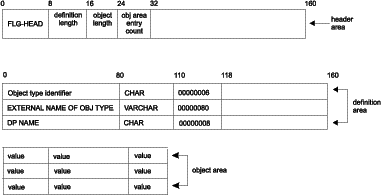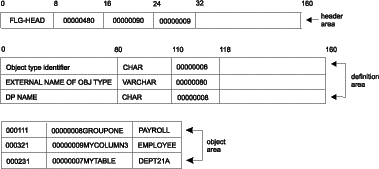
Displays all object types currently registered and created in the information catalog database.
Authorization
Administrator or user
Syntax
APIRET APIENTRY FLGListObjTypes( PFLGHEADERAREA * ppListStruct,
PFLGEXTCODE pExtCode );
Parameters
Each entry has the following information:
Entries are sorted by 80-byte object type external name (EXTERNAL NAME OF OBJ TYPE); the actual order depends on the collating sequence used by the database management system used for the information catalog.
See Appendix D, Information Catalog Manager reason codes for an explanation of the returned reason codes.
Output structure
FLGListObjTypes produces an output structure containing a list of object types, as shown in Figure 104.
The object area of the output structure contains a list of all the object types in the information catalog. These object types are identified by the values of the object type ID, the object type external name, and the object type DP NAME (short name).
Figure 104. FLGListObjTypes output structure

For an explanation of the meanings of the byte offsets, see The Information Catalog Manager API output structure.
Usage
Freeing memory allocated for an output structure
If FLGListObjTypes returned data in the output structure, you must save the data returned in the output structure and then call FLGFreeMem (see FLGFreeMem). Do not use other methods, for example, C language instructions, to free memory.
Figure 105 shows the C language code required to invoke the FLGListObjTypes API call. This sample code retrieves a list of all the object types in the information catalog.
Figure 105. Sample C language call to FLGListObjTypes
PFLGHEADERAREA * ppListStruct; // pointer to output structure pointer
APIRET rc; // reason code from FLGListObjTypes
FLGEXTCODE ExtCode=0; // extended code
.
.
.
rc = FLGListObjTypes (ppListStruct, // address of output structure pointer
&ExtCode );
Figure 106 shows the output structure for this API call.
Figure 106. Sample output structure for FLGListObjTypes
